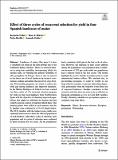Por favor, use este identificador para citar o enlazar a este item:
http://hdl.handle.net/10261/335073COMPARTIR / EXPORTAR:
 SHARE SHARE
 CORE
BASE CORE
BASE
|
|
| Visualizar otros formatos: MARC | Dublin Core | RDF | ORE | MODS | METS | DIDL | DATACITE | |

| Título: | Effect of three cycles of recurrent selection for yield in four Spanish landraces of maize |
Autor: | Ordás López, Bernardo CSIC ORCID; Malvar Pintos, Rosa Ana CSIC ORCID ; Revilla Temiño, Pedro CSIC ORCID ; Ordás Pérez, Amando CSIC ORCID | Palabras clave: | European germplasm Maize Prebreeding Recurrent selection |
Fecha de publicación: | 22-jun-2023 | Editor: | Springer | Citación: | Euphytica 219 (2023) | Resumen: | Landraces of maize (Zea mays L.) have a variability not found in the elite hybrids due to the bottleneck during selection. There is a renewed interest in using that variability, incorporating alleles for specific traits, or widening the general variability of elite germplasm. In Europe, there is also an interest in the direct use of local landraces by farmer’s associations seeking agriculture that preserves crop diversity. Pre-breeding programs are aimed to reduce the yield gap among landraces and improved materials. In the Misión Biológica de Galicia we have carried out three cycles of a S recurrent selection program for yield on four local landraces from Northwestern Spain with the objective of obtaining improved populations that might be cultivated by farmers and that could be used as sources of superior inbred lines. One hundred plants were selfed in each landrace and the S families were evaluated in a 10 × 10 simple lattice. The 20 S families with the highest grain yields were randomly intercrossed to form the selected population of each landrace. After three cycles of selection, each population and its cycles of selection were evaluated in three locations for two years. All the populations had a consistent yield gain in the first cycle of selection. However, the response in later cycles differed among the populations: one population had a continuous increase of 21% per cycle while two populations had a reduced yield in the last cycles. Our results highlight the need to include secondary traits to avoid unintentional indirect effects. We conclude that, in pre-breeding programs, it could be worthy to use large effective numbers to prevent inbreeding depression, particularly when the objective is the direct use of improved landraces. Another conclusion is that recurrent selection does not seem to be as efficient on European germplasm as it is on Corn Belt varieties. Finally, obtaining valuable new germplasm requires a sustained, long-term effort. | Descripción: | 11 páginas, 9 tablas | Versión del editor: | http://dx.doi.org/10.1007/s10681-023-03199-w | URI: | http://hdl.handle.net/10261/335073 | DOI: | 10.1007/s10681-023-03199-w | Identificadores: | doi: 10.1007/s10681-023-03199-w issn: 1573-5060 |
| Aparece en las colecciones: | (MBG) Artículos |
Ficheros en este ítem:
| Fichero | Descripción | Tamaño | Formato | |
|---|---|---|---|---|
| Euphytica2023_Effect.pdf | 488,77 kB | Adobe PDF |  Visualizar/Abrir |
CORE Recommender
SCOPUSTM
Citations
2
checked on 20-abr-2024
WEB OF SCIENCETM
Citations
2
checked on 25-feb-2024
Page view(s)
32
checked on 01-may-2024
Download(s)
21
checked on 01-may-2024
Google ScholarTM
Check
Altmetric
Altmetric
Este item está licenciado bajo una Licencia Creative Commons

